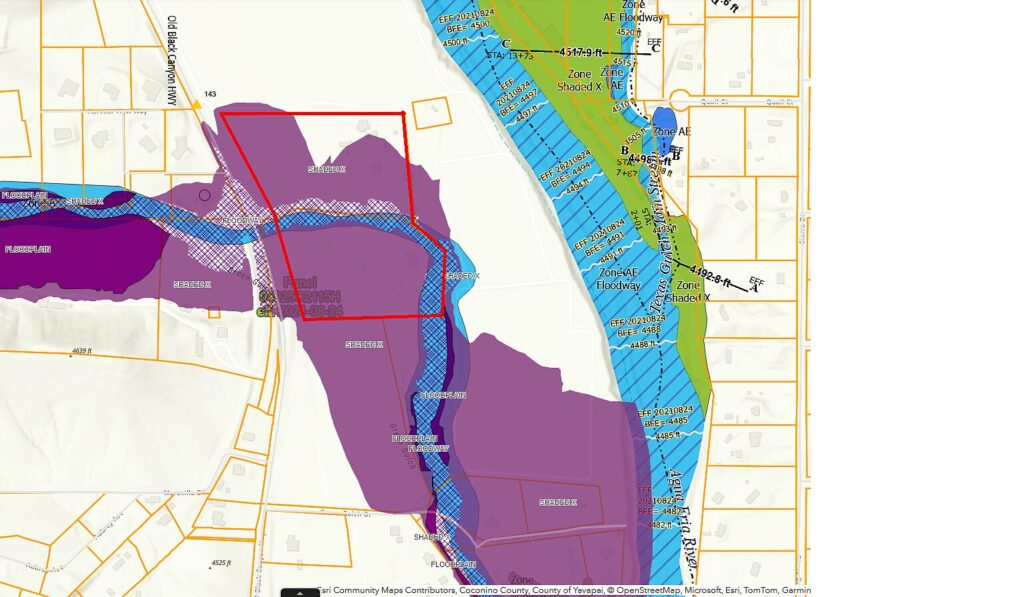There are two main happenings on the north side of Old Black Canyon Hwy near SR169 and SR69. The Town has purchased property on OBCH and they have also given their consent to several land owners to close a section of the road from public access. The Town Council has also voted to take Mr. Bartol’s land using the Town’s powers of condemnation to rework OBCH.
**Update 11-4-2025 – Mr. Bartol has accepted the offer from the town to keep them from taking it, see town meeting https://dhaz.granicus.com/player/clip/2513?view_id=2&redirect=true There should be a final deal voted by council soon.
Purchase and Build Issues:

Yavapai County Flood MAP and the Town Property on Old Black Canyon HWY
Town Property Outlined in Red Above:
The shaded areas in the map above indicates a flood zone. All construction in any flood zone requires a licensed engineer’s approval, approved plans by the engineer and county or state flood control approval. All land is buildable but costs of engineering will add to construction cost as noted below . No projected cost to build on the site has been issued by the town as of yet.
Concerns with Floodplain Construction:
Building on a floodplain involves substantial extra costs, driven by regulations and the need to protect the structure from flood damage. These costs arise both during construction and over the lifespan of the property.
Initial construction and engineering costs:
- Elevation: Building above the Base Flood Elevation (BFE) is the most significant added cost. This can be done by using an elevated foundation, such as stilts, piers, or columns.
- According to Fixr.com, the average cost to raise a house above a flood zone is $25,000 to $40,000, depending on the height of the elevation.
- For a new foundation, costs can range from $10 to over $60 per square foot, with a full basement being the most expensive option.
- Fill: While raising a property using fill material can also be used, it may create drainage issues for neighboring properties.
- Permits and professional services: You will need to hire structural engineers, surveyors, and architects with expertise in floodplain construction. Permits for this specialized work are more expensive and can take longer to obtain than for typical construction.
- Flood-resistant materials: Using water-resistant building materials is often required or recommended for portions of the home below the flood elevation.
- Elevated utilities: All major utility systems—including electrical, plumbing, and HVAC—must be installed above the BFE. This requires additional labor and materials and may affect the layout of the home.
Long-term and ongoing costs:
- Higher flood insurance premiums: If your property is in a high-risk flood zone, you will likely be required to purchase flood insurance, which is separate from homeowners insurance and can be very expensive. A structure that is not in full compliance with current flood regulations will face even higher premiums. However, building higher than the BFE can significantly lower these costs over time.
- Flood damage and repair: Even with mitigation efforts, a major flood can cause damage that is costly and stressful to repair. Floodwaters can damage landscaping, roads, and vehicles, which are not typically covered by flood insurance.
- Risk of devaluation: The potential for flooding can make your property harder to sell, especially to buyers who are risk-averse or concerned about high insurance premiums. Studies show that homes in floodplains can be overvalued because buyers fail to properly account for the long-term risks.
- Inconvenience: An elevated home may require additional accessibility features, such as stairs or elevators, which add to the overall cost. You may also face the inconvenience of evacuation during flood events.
Costs in the event of substantial damage:
- Increased Cost of Compliance (ICC) coverage: If your home is substantially damaged by a flood and needs major repairs, ICC coverage—part of most flood insurance policies—can help pay for the additional costs of bringing the structure into compliance with current flood regulations. This coverage is capped at $30,000.
- The “50% Rule”: A floodplain management regulation states that if the cost of improving or repairing a substantially damaged structure exceeds 50% of its market value, the entire structure must be brought into full compliance with current flood regulations.
Link to Industry Insight on Insurance
MORE TO COME – additional information will be added to this page in the coming days including council minutes, road closure details and town council taking of private property.
